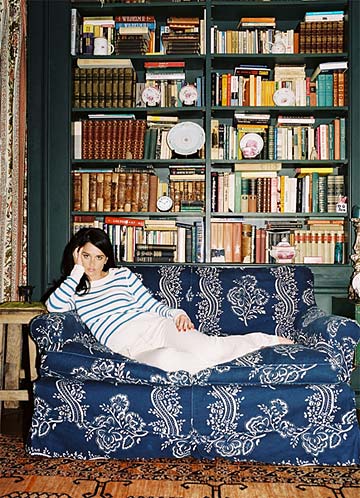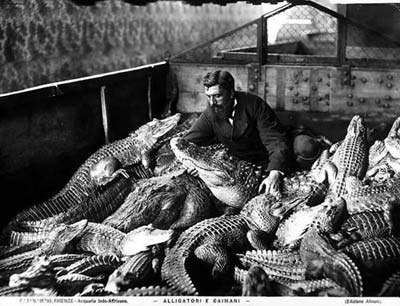
Anyone who sets out to write an essay — for a school or college class, a magazine or even the book review section of a newspaper — owes something to Michel de Montaigne, though perhaps not much. Montaigne was a magistrate and landowner near Bordeaux who retired temporarily from public life in 1570 to spend more time with his library and to make a modest memento of his mind. He called his literary project “Essais,” meaning “attempts” or “trials,” and the term caught on in English after Francis Bacon, the British philosopher and statesman, used it for his own collection of short pieces in 1597. (…)
Oddly, Montaigne learned to speak Latin before he learned to speak anything else, thanks to his father’s strict ideas about schooling. But he chose to write in French, which he expected would change beyond recognition within 50 years, rather than a more “durable” tongue.
{ NY Times | Continue reading }
photo { Annabel Mehran }
Linguistics, books, ideas |
March 11th, 2011

John Gapper makes a good point: management consultants in general, and McKinsey consultants in particular, have made their entire business out of exploiting the moral grey zone surrounding confidential information.
The reason you hire McKinsey is that its consultants have seen strategic business issues like yours before, and therefore might have developed good insights into how to approach them. But the reason they’re familiar with those issues is that they’ve been given highly confidential information about your competitors. So when you hire McKinsey you’re essentially trying to acquire, for a very high hourly fee, the kind of corporate intelligence that can only be built up through long exposure to highly-sensitive commercial information. (…)
In this sense, a management consultant is a bit like an art dealer, or anybody else who traffics in valuable information asymmetries. The consultant knows more than the client, when it comes to strategic issues within the industry in question. If the client wants access to that knowledge, he has to open his own kimono to get it, thereby putting the consultant at yet more of an information advantage.
{ Felix Salmon/Reuters | Continue reading }
economics, ideas |
March 11th, 2011
asia, elements, horror, science |
March 11th, 2011
 Swedish Bank Robber Busted by Forgotten Urine.
Swedish Bank Robber Busted by Forgotten Urine.
Lockheed Martin Tried to Trade F-16s for Frozen Chickens.
China Threatens Death Penalty for Food Safety Violations.
Boy found dead in oven at his family’s home.
“I Just Broke Into A House And The Owner Came Home,” Intruder Tells 911 Operator. “I think she’s got guns.”
People in Seattle who would never touch heroin are trying fentanyl. What they don’t know is that it’s basically the same thing, only stronger.
Less educated police officers are found to be more likely to use force.
Idaho Rancher Revealed as Gangster From Boston. A wanted man started over with a new name and a new life in Idaho, but then his past caught up with him.
Big-screen TV stolen in reverse prison break.
More than 60 people, including ‘Snoop’ of ‘The Wire,’ arrested in drug raids in Baltimore.
‘Half-fro’ mug shot of dealer caught mid-haircut.
About one in 20 survey participants reported they’d dozed off while driving at least once in a month.
Where does WikiLeaks keep its secrets? In a former military bunker and nuclear shelter under Stockholm’s city streets.
 The government’s unnoticed Europe crisis.
The government’s unnoticed Europe crisis.
Daniel Kish has been sightless since he was a year old. Yet he can mountain bike. And navigate the wilderness alone. And recognize a building as far away as 1,000 feet. How? The same way bats can see in the dark.
Professor Tim Birkhead is one of the pioneers of spermatology. He explains how promiscuous females can be selective about sperm, even after multiple inseminations.
Has Viagra helped endangered species by reducing demand for rhino horn, etc?
How anger can make us more rational.
How well our brain functions is largely based on our family’s genetic makeup, according to a new study.
Tropical Water Ice Discovered On Mars.
India’s space agency announced it had discovered an enormous volcanic cave under the surface of the moon.
In this article, I focus on the definition of one word in particular: probability.
Introduction to Sociosystemics: Science About the Utilizing of Social Sciences. And (whatever that means): The semiotic organization of the research process in the social sciences.
Should Computer “Languages” Qualify as Foreign Languages for Ph.D.s?
Data Mining: How Companies Now Know Everything About You.
Is Twitter Worth More Than We Think? CNBC’s John Melloy mentions what may be the best analysis I’ve seen on the “Charlie Sheen effect.”
Can Punk Change the Way We Think About Law?
A Dynamic Theory of Battle Victory and Defeat.
Notes On Asymmetric War.
Did Archaeologists Uncover Blackbeard’s Treasure? Cannons. Gold dust. Turtle bones. For archaeologists researching the notorious pirate’s flagship, every clue is priceless.
After earning a fortune processing online-porn payments, Chris Mallick spent $32 million to make Middle Men, a movie about his fabulous rise. It bombed; but that was just the beginning of his problems.
Dan Savage, the brilliant and foul-mouthed sex columnist, has become one of the most important ethicists in America. Are we screwed?
The MGM follies began in 2004, when its owner, Kirk Kerkorian, who had made a fortune buying and selling MGM, decided the time was ripe to sell it yet again.
The Confidence Man. How Lalit Modi, possessed of inhuman energy, ambition and audacity, built a billion-dollar cricket kingdom—only to be rudely ejected from its throne.
Two of Wall Street’s savviest value investors, Bruce Berkowitz and David Einhorn, pride themselves on their rigorous analysis. Now they’re locked in a scorched-earth dispute over the value of some Florida real estate. How could they look at the same facts and reach such wildly different conclusions, and what does that say about the “value” of value investing?
‘Tiger, Tiger’ by Margaux Fragoso: The Incandescent Memoir of a Real-Life Lolita.
Is it possible for fraternal twins to have different fathers?
Tom Waits has teamed up with The David Lynch Foundation to help launch DLF Music and their ‘Download for Good’ campaign on PledgeMusic.
The Story of Eames Furniture: Marilyn Neuhart with John Neuhart - Interview. [video]
The complexities of our brain. [video]
 The 10 Most Innovative Companies in Music.
The 10 Most Innovative Companies in Music.
How to make really good coffee.
Start watching the video above and you may not believe that it features an ordinary chessboard.
Alexander Calder’s code.
Insane asylum plans.
Writes 2 kms.
Florida church billboard welcomes “Scumbags.”
Art Boobs.
For Y’ur Height Only.
Woman on the phone.
Whoopla.
every day the same again |
March 11th, 2011

Mankind may have unleashed the sixth known mass extinction in Earth’s history, according to a paper released by Nature.
Over the past 540 million years, five mega-wipeouts of species have occurred through naturally-induced events.
But the new threat is man-made, inflicted by habitation loss, over-hunting, over-fishing, the spread of germs and viruses and introduced species and by climate change caused by fossil-fuel greenhouse gases, says the study.
Evidence from fossils suggests that in the “Big Five” extinctions, at least 75 percent of all animal species were destroyed.
Palaeobiologists at the University of California at Berkeley looked at the state of biodiversity today, using the world’s mammal species as a barometer.
Until mankind’s big expansion some 500 years ago, mammal extinctions were very rare: on average, just two species died out every million years.
But in the last five centuries, at least 80 out of 5,570 mammal species have bitten the dust, providing a clear warning of the peril to biodiversity.
{ The Independent | Continue reading }
images { 1. Erik Foss | 2. Alejandro Garcia }
horror, science |
March 10th, 2011

Sex would be a very different proposition for humans if — like some animals including chimpanzees, macaques and mice — men had penises studded with small, hard spines.
Now researchers at Stanford University in California have found a molecular mechanism for how the human penis could have evolved to be so distinctly spine-free. They have pinpointed it as the loss of a particular chunk of non-coding DNA that influences the expression of the androgen receptor gene involved in hormone signalling.
The research also suggests a molecular mechanism for how we evolved bigger brains than chimpanzees and lost the small sensory whiskers that the apes — who are amongst our closest relatives and with whom it has been estimated we share 96% of our DNA — have on their face.
{ Nature | Continue reading }
artwork { Tom Gallant, Japanese Iris, 2010 | Cut paper, glass, wood }
genes, science, sex-oriented |
March 10th, 2011

The brain may manage anger differently depending on whether we’re lying down or sitting up, according to a study published in Psychological Science that may also have worrying implications for how we are trying to understand brain function. (…)
A field of study called ‘embodied cognition‘ has found lots of curious interactions between how the mind and brain manage our responses depending on the possibilities for action.
For example, we perceive distances as shorter when we have a tool in our hand and intend to use it, and wearing a heavy backpack causes hills to appear steeper.
{ Mind Hacks | Continue reading }
brain, psychology, relationships |
March 10th, 2011

The principle of all things entrails made
Of smallest entrails; bone, of smallest bone,
Blood, of small sanguine drops reduced to one;
Gold, of small grains; earth, of small sands compacted
Small drops to water, sparks to fire contracted.
{ Lucretius quoted by Ralph W. Emerson | Continue reading }
poetry |
March 10th, 2011
photogs |
March 10th, 2011

In the mid 1920s, Berger invented the electroencephalagraph (EEG), a technique for measuring the electrical activity of brains. Unfortunately, Berger didn’t understand electricity very well, so didn’t have a clear understanding of what his recordings might mean. But he revolutionized the study of human brains.
Perhaps nowhere was Berger’s invention put to greater use than in the study of sleep. Before that, what did we know of brains while we slept? (…)
Berger’s invention continues to deepen our understanding of sleep, nearly a century after its invention, as shown by a new paper by KcKinney and colleagues.
{ NeuroDojo | Continue reading }
related { Short on sleep, the brain optimistically favors long odds }
painting { John Kacere }
science, sleep |
March 10th, 2011

{ A small number of randomly selected legislators should make parliaments more effective, say a group of IgNobel prize-winning scientists. | The Physics arXiv Blog | full story | Photo: Tim Davis }
ideas, science |
March 10th, 2011

Since morals didn’t come from a God, where did they come from?
Nietzsche answered that question in 1887 with his Genealogy of Morals, which is the best, and by far the clearest, introduction to Nietzsche’s overall project. In short, the first essay in the three-part Genealogy argues that morality itself, the whole idea of good versus evil, came about when weak people figured out a way to make strong people feel bad about being strong. The reason we feel that we should take pity on the weak, or feel bad for imposing our wills on others, is that long ago, in some dark, underground workshop of the spirit, the weak had invented “morals” to compensate for their weakness.
Instead of just straightforwardly hating their enemies, they declared that their superiors stood under the judgement of a higher authority, God, whose law condemned them. And then, amazingly, they had convinced the strong to accept these twisted ideals as The Way Things Ought To Be.
{ Fred Sanders | Continue reading }
nietzsche |
March 10th, 2011

Dazzle camouflage, also known as Razzle Dazzle or Dazzle painting, was a camouflage paint scheme used on ships, extensively during World War I and to a lesser extent in World War II. Credited to artist Norman Wilkinson, it consisted of a complex pattern of geometric shapes in contrasting colours, interrupting and intersecting each other.
{ Wikipedia | Continue reading | more photos }

Face-detection software is everywhere. Defeat it with some artfully-applied, avant-garde face makeup called CV Dazzle.
CV Dazzle is named after the ingenious warship-camouflage designs deployed during World War I. Rather than actually hiding military vessels, the bold, jagged paint jobs made it difficult for naval rangefinders to discern details about the ship’s size, heading, armament, and so forth. Or at least, that was the idea — unlike Harvey’s digital version, the original Dazzle’s effectiveness was never proven. Of course, CV Dazzle benefits from the fact that face-detection software is much stupider than WWI seamen: you only have to apply a few strokes of face-paint to confuse it, rather than coat your whole kisser.
{ Fast Company| Continue reading }
flashback, guide, technology, visual design |
March 10th, 2011

The brain does not stop developing until we are in our 30s or 40s – meaning that many people will still have something of the teenager about them long after they have taken on the responsibilities of adulthood.
The finding, from University College London, could perhaps help explain why seemingly respectable adults sometimes just can’t resist throwing a tantrum or sulking until they get their own way.
The discovery that the part of the brain key to getting on with others takes decades to fully form could perhaps also explain why some people are socially awkward well past their teenage years.
Neuroscientist Professor Sarah-Jayne Blakemore said: ‘Until about 10 years ago, it was pretty much assumed that the human brain stops developing in early childhood.
‘But we now know that is far from the truth, in fact most regions of the human brain continue to develop for many decades.
{ Daily Mail | Continue reading }
photo { Fette Sans }
neurosciences, time |
March 10th, 2011
haha, video |
March 10th, 2011

In a book to be published in April, “The Origins of Political Order,” Francis Fukuyama of Stanford University presents a sweeping new overview of human social structures throughout history. (…)
Dr. Fukuyama, a political scientist, is concerned mostly with the cultural, not biological, aspects of human society. But he explicitly assumes that human social nature is universal and is built around certain evolved behaviors like favoring relatives, reciprocal altruism, creating and following rules, and a propensity for warfare.
Because of this shared human nature, with its biological foundation, “human politics is subject to certain recurring patterns of behavior across time and across cultures,” he writes. It is these worldwide patterns he seeks to describe in an analysis that stretches from prehistoric times to the French Revolution.
Previous attempts to write grand analyses of human development have tended to focus on a single causal explanation, like economics or warfare, or, as with Jared Diamond’s “Guns, Germs and Steel,” on geography. Dr. Fukuyama’s is unusual in that he considers several factors, including warfare, religion, and in particular human social behaviors like favoring kin.
Few people have yet read the book, but it has created a considerable stir in universities where he has talked about it.
{ NY Times | Continue reading }
photo { Nathan Osterhaus }
flashback, ideas |
March 10th, 2011

An investigation conducted at the Edinburugh Science Festival by psychologists James Houran, Caroline Watt and Richard Wiseman looked into what topics of conversation are the most sucessful in a dating situation. One hundred randomly selected participants (50 men and 50 women) engaged in the scientific speed dating. (…)
Talking about films was the least successful topic with only 9% saying that they would like to see the other person again, whilst 18% who discussed travel (the most popular topic) wanted to meet again. The poor showing for film was attributed to the differences in film tastes between men and women, also Wiseman observed that whenever he walked past the film table the participants were just arguing!
Also discovered was that 45% of womens descisions were made during the first 30 seconds, whilst only 22% of men made their descision in that time.
{ B Good Science | Continue reading }
relationships |
March 10th, 2011

…everyone will agree that there are no restraints against the formation of organic compounds from non-organic reactants. This has been demonstrated since 1952 when Stanley Miller and Harold Urey did their famous experiment. (…) In fact, organic compounds have been found in the oddest places; Titan, nebula, and meteorites.
Now, the question, of course, is how did these disparate pieces come together and form the living system we see today?
{ Cassandra’s Tears | Continue reading }
The Miller and Urey experiment was an experiment that simulated hypothetical conditions thought at the time to be present on the early Earth, and tested for the occurrence of chemical origins of life.
Specifically, the experiment tested Oparin’s and Haldane’s hypothesis that conditions on the primitive Earth favored chemical reactions that synthesized organic compounds from inorganic precursors. Considered to be the classic experiment on the origin of life, it was conducted in 1952 and published in 1953.
{ Wikipedia | Continue reading }
installation { Dimension/Next, Miller-Urey Bong, 2010 | Dimension/Next specifically proposes that the addition of C21H30O2 to the existing Miller-Urey hypothesis of CH4 + NH3 + H2 + H20 has a high chance of producing exceptional results. }
flashback, science |
March 10th, 2011

Supposing truth is a woman - what then? Are there not grounds for the suspicion that all philosophers, insofar as they were dogmatists, have been very inexpert about women? That the gruesome seriousness, the clumsy obtrusiveness with which they have usually approached truth so far have been awkward and very improper methods for winning a woman’s heart?
{ Friedrich Nietzsche, Beyond Good and Evil, 1885-86 | Continue reading }
related { circa 1730: Female orgasm officially demoted. }
nietzsche, relationships |
March 8th, 2011
























